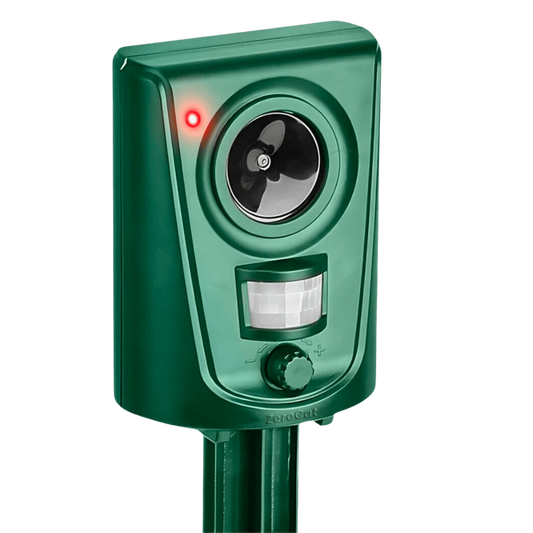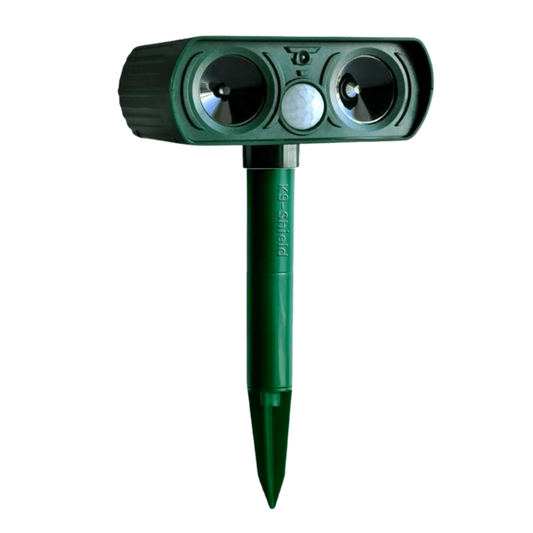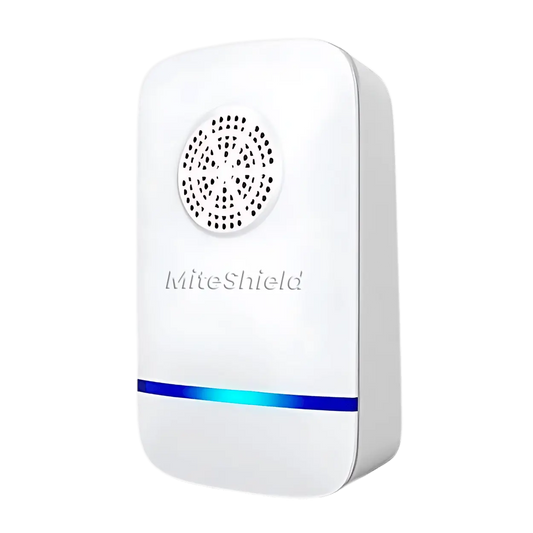Certain sounds can be powerful allies in setting boundaries with dogs. From high-frequency tones to everyday noises that trigger discomfort, sound-based deterrents offer a humane and effective way to create dog-free zones. In this guide, you’ll discover which sounds work best and how to use them wisely for lasting results.
Why consider using sounds to keep dogs away?
Dogs are highly sensitive to sound, much more than humans. Their acute hearing allows them to detect high-pitched frequencies and subtle noises we often can’t even perceive. This unique sensitivity makes sound-based repellents a practical and non-invasive way to deter them from certain areas.
Unlike physical barriers or chemical sprays, sound deterrents don’t require direct contact or constant reapplication. A well-placed noise can trigger a natural discomfort in dogs, prompting them to retreat without causing harm. This approach is especially helpful for people who want to keep dogs away from gardens, entrances, vehicles, or private property.
High-pitched sounds that dogs hate
High-pitched sounds are among the most effective audio cues for repelling dogs because they fall into a frequency range that dogs hear far more acutely than humans. While we typically hear up to 20,000 Hz, dogs can detect sounds up to 65,000 Hz, which means certain noises we barely notice can be highly uncomfortable for them.
Ultrasonic devices are designed specifically around this principle. Generating tones above 20,000 Hz, these gadgets produce a sharp, high-pitched sound that irritates dogs without harming them. You won’t hear anything, but for dogs, the sound is piercing and often enough to keep them away or stop unwanted behavior. The K9 Shield ultrasonic repellent uses this same technology to gently push dogs out of unwanted zones — no noise, no chemicals, just results.
Even common household items can produce tones that are bothersome to dogs. Whistles used in training, particularly those designed for long-distance recall, often fall into the ultrasonic range. High-frequency beeping from alarms, timers, or old electronics can also be unsettling, especially when unexpected.
Used wisely, these sounds offer a safe and silent deterrent. Just be sure to avoid overuse, as constant exposure may cause anxiety or lead to desensitization, making them less effective over time.
Loud noises known to keep dogs away
These sounds tap into a dog’s natural survival instincts, especially if they’re unpredictable or associated with past fear. Let’s take a closer look at the types of loud noises that commonly repel dogs:
Thunderstorms

Many dogs develop an intense fear of thunderstorms due to the combination of loud claps of thunder, changes in atmospheric pressure, and static electricity in the air. Even distant rumbles can make dogs uneasy, leading them to hide or avoid outdoor spaces. This aversion can be used to your advantage.
Fireworks

The sharp, erratic explosions of fireworks are one of the most distressing experiences for dogs. The combination of unexpected flashes, bangs, and vibrations overwhelms their senses. In many cases, dogs will avoid locations where fireworks have previously caused distress, making it a potential deterrent, though this method should be used with caution to avoid excessive fear or trauma.
Gun Shots

Gunshots are abrupt, extremely loud, and often accompanied by a shockwave that intensifies the impact on a dog's hearing. Even trained working dogs can be startled by gunfire. For stray or untrained dogs, the sound often causes immediate flight. In some rural or farm areas, recordings of gunfire are used sparingly as a sound-based repellent, though not recommended for regular residential use due to legal and ethical concerns.
Vacuum Cleaners

The low-frequency roar and unpredictable movement of vacuum cleaners make them surprisingly effective at driving dogs away. Many dogs associate the vacuum with disruption or fear, especially if introduced poorly during puppyhood. While this isn’t a long-range solution, leaving a running vacuum in certain rooms or entryways can act as a short-term indoor deterrent.
Crying babies

While not traditionally considered a repellent, the sharp, high-pitched wail of a crying baby can trigger anxiety or restlessness in some dogs. The sound mimics distress signals that dogs instinctively respond to. In homes where a dog is sensitive to baby cries, they may avoid rooms where those sounds are frequent, although this effect varies greatly by temperament and training.
Construction Noises

Jackhammers, drills, and heavy machinery create powerful sound waves that are not only loud but also deeply resonant (something dogs find particularly uncomfortable). The chaotic, metallic nature of these noises makes construction sites naturally uninviting to most dogs. Even short exposure to such environments can cause them to steer clear for good. These sounds are especially useful in urban deterrent strategies, though they're typically incidental rather than intentional.
Car Alarms

The repetitive, unpredictable blaring of a car alarm is disorienting for dogs. The sharp pitch, rapid intervals, and lack of pattern can overwhelm their senses, triggering a flight response. While you wouldn’t want to activate a car alarm regularly just to repel dogs, some motion-triggered alarms placed in parked vehicles or garages can act as passive sound barriers.
Sirens

Whether from ambulances, police cars, or fire trucks, sirens generate a range of modulating frequencies that pierce through the air. Dogs often respond with agitation, howling, or avoidance. The rising and falling tones resemble alarm cries in the animal world, instinctively warning of danger. If a location is close to a road with frequent siren traffic, it may already have a natural deterrent effect on sensitive dogs.
Jet Airplanes

While jet engines aren’t an everyday sound for most people, their deafening roar, especially during takeoff, can be highly unsettling for dogs. The intense vibrations and prolonged noise make many dogs retreat indoors or avoid the area entirely. For those living near airports, this can inadvertently reduce dog traffic in yards and parks near the runway path.
Air Conditioners or Furnaces

Though not as aggressively loud as others on this list, certain older or industrial-grade air conditioners and furnaces produce a low hum, vibration, or rattling that some dogs find distressing. Dogs with heightened noise sensitivity might steer clear of areas near outdoor AC units, HVAC vents, or boiler rooms where these sounds persist.
Things you need to consider before using sounds to keep dogs away
Before turning to sound as a method to keep dogs away, it's essential to understand how it works and when it might not be the right fit. While sound deterrents can be effective and humane, they require thoughtful use to ensure they deliver results without causing unnecessary stress, either to the dogs or to people nearby.
1. Every dog reacts differently
What works for one dog might be completely ignored by another. Breed, age, past experiences, and even hearing sensitivity can all influence how a dog responds to a specific sound. Some may flee instantly, while others become curious or even more agitated.
2. Use with moderation
Repeated exposure to the same noise can lead to desensitization. If the sound becomes part of the environment, dogs may learn to ignore it. To maintain effectiveness, vary the timing or type of sound and avoid constant playback.
3. Avoid inducing fear or distress
The goal is deterrence, not distress. Sounds should make an area unappealing, not terrifying. Prolonged fear-based exposure may lead to anxiety, behavioral issues, or even aggression.
4. Consider your surroundings
Some sound repellents, especially loud or high-pitched ones, can also affect humans, particularly children or those with sensitive hearing. Neighbors may also hear them. Opt for directional or ultrasonic devices in populated areas to limit disruption.
5. Respect local laws and ethics
Certain noise-producing devices may be restricted in residential zones or subject to noise regulations. Ensure your solution complies with local rules and always prioritizes humane treatment, even when dealing with difficult cases.
Tips for using sounds to keep dogs away
Here are practical tips to maximize the effectiveness of sound-based dog deterrents:
- Start with short bursts: Use sound deterrents in short intervals to avoid overstimulation or desensitization.
- Target specific zones: Place devices near areas where dogs frequently intrude (entrances, gardens, trash bins).
- Use motion sensors: Opt for motion-activated sound repellents for smarter, energy-efficient use and minimal disruption.
- Change the sound periodically: Vary the pitch or pattern to prevent dogs from getting used to a single sound.
- Avoid nighttime use: Refrain from activating loud sounds at night to prevent disturbing neighbors or household members.
- Observe reactions: Monitor the dog's behavior to ensure the sound is having the intended effect, not causing extreme stress.
- Combine with other methods: Reinforce sound deterrents with scent repellents or barriers for long-term success.
- Place devices at dog ear height: Position sound emitters at the appropriate level (20–40 cm from the ground) for better targeting.
- Maintain your devices: Check batteries and sensors regularly to ensure continued functionality.
- Use responsibly: Be mindful of other pets or wildlife nearby that could also be affected by the sound.
Alternatives to sounds to keep dogs away
While sound is an effective tool to deter dogs, it’s not the only option. In fact, combining multiple strategies often yields better and longer-lasting results. Here are some proven approaches that can help you keep dogs away without relying solely on noise.
Natural smells that repel dogs
Dogs have an extraordinary sense of smell, which means certain scents can be powerful deterrents. Vinegar, citrus peels, chili pepper, ammonia, and coffee grounds are all known to bother canine noses. You can soak cotton balls in these substances or use DIY sprays around problem areas like flower beds, trash bins, or entryways. These natural solutions are safe, easy to apply, and particularly effective when refreshed regularly.
Physical barriers and fencing
Nothing beats a clear physical limit. Installing fences, hedges, or even temporary barriers can immediately prevent dogs from accessing specific areas. For digging deterrents, burying chicken wire just beneath the soil’s surface works well. For jumping dogs, taller fences or angled toppers discourage intrusion. If visibility is an issue, motion-triggered lights or reflective surfaces can also signal that the space is off-limits.
Motion-activated sprinklers
These clever devices detect movement and instantly spray a short burst of water. Most dogs dislike sudden water jets, and the surprise factor is often enough to stop them from coming back. They’re also eco-friendly and double as watering tools for your garden. Models like the JetSentinel are a good example: adjustable in range and angle, they let you cover different parts of a yard without much effort.
Commercial dog repellents
There’s a diverse range of ready-to-use commercial products designed specifically to keep dogs away. These include repellent sprays (scent-based), ultrasonic repellents like the K9 shield (one of the best ultrasonic dog repellents on the market and one of the best ways to repel dogs from your yard), repellent granules, and even pressure-activated mats. Many are formulated to be safe for pets and plants alike. For quick and easy protection, these products offer convenience and tested formulas.
FAQ
Do sounds really work to keep dogs away?
Yes, sounds can be a highly effective way to deter dogs from certain areas. Dogs have far more sensitive hearing than humans, allowing them to detect frequencies and intensities that can feel overwhelming or unpleasant. Ultrasonic deterrents, loud or sudden noises, and even certain household sounds can trigger discomfort or a startle reflex in dogs, encouraging them to leave or avoid a space. However, results can vary based on the dog’s age, breed, experience, and hearing sensitivity. For best results, sound should be part of a broader strategy that includes scent repellents or physical barriers to reinforce the message that the space is off-limits.
Can you use sounds to keep dogs away without harming them?
Absolutely. When used responsibly, sound-based repellents are one of the most humane methods available to deter dogs. The key is moderation and proper placement. Ultrasonic repellents, for example, produce high-frequency tones that are annoying to dogs but not damaging to their hearing. These sounds don't cause physical pain but simply create an unpleasant environment that dogs instinctively want to avoid. Avoid excessively loud or constant noises, as they can cause stress or anxiety if overused.
Which sounds frequencies irritate dogs and keep them away?
Dogs are capable of hearing frequencies between 40 Hz and 65,000 Hz, far beyond the human hearing range. Sounds above 20,000 Hz are classified as ultrasonic and are particularly effective in repelling dogs because they are audible to them but silent to most humans. Devices that operate between 25,000 and 30,000 Hz tend to strike a balance between effectiveness and safety. These frequencies create a high-pitched noise that’s uncomfortable for dogs but non-damaging when used for short periods. It's important to choose a device with an adjustable frequency range to find what works best without overstimulating or causing distress.
How often can you use sound to keep dogs away without long-term effects?
Sound deterrents should be used strategically rather than continuously. Repeated or constant exposure to the same sound can cause two unwanted outcomes: desensitization (the dog gets used to the sound and ignores it) or stress (the dog becomes anxious or fearful). Ideally, sound deterrents should be motion-activated or used only during peak intrusion times, like early mornings or evenings. This limits stress while maintaining effectiveness. For long-term success, vary the type or pattern of sound and pair it with other deterrents (like scent or fencing) to avoid over-reliance on any one method.
What is the most irritating sound for dogs?
The most irritating sound for most dogs tends to be high-frequency, unpredictable noises. Ultrasonic frequencies are at the top of the list because they are extremely uncomfortable without being painful. Other commonly irritating sounds include fireworks, sirens, and loud, metallic construction noises. Sudden and jarring sounds with no clear source are also unsettling to dogs, triggering their flight response. It’s important to note that what’s irritating to one dog might not affect another in the same way, so some trial and observation may be needed to identify the most effective sound in your situation.
Which sounds are most frightening to dogs?
Sounds that are sudden, loud, and erratic tend to frighten dogs the most. Thunderstorms and fireworks are among the most common triggers for fear in dogs due to their booming noise, sudden bursts, and unpredictable patterns. Gunshots, sirens, and vacuum cleaners also frequently rank high on the fear scale, especially for dogs that haven’t been desensitized to them. These sounds mimic natural threats or emergencies, activating the dog's fight-or-flight response. While fear can be a deterrent, it should never be the goal. Using sound as a repellent should be about discomfort and avoidance, not panic or trauma.
Which methods work best besides using sound to keep dogs away?
Several alternative methods can be just as effective as sound, especially when used in combination. Natural smell repellents for dogs, such as citrus, vinegar, or ammonia, can be applied around garden beds, furniture, or doorways to discourage dogs from entering. Physical barriers like fences, netting, or cat-scatter mats prevent access entirely, especially when digging or jumping is the issue. Commercial repellents, available in spray, granule, or motion-sensor form, offer convenience and targeted application. Behavioral approaches, like training or redirection, can also work if the dog is a regular visitor or your own pet.









